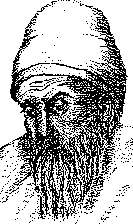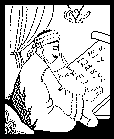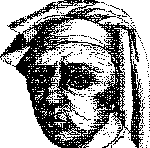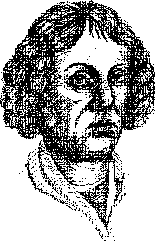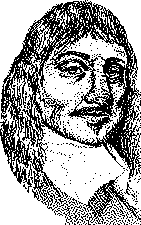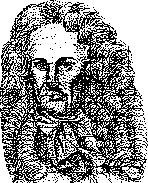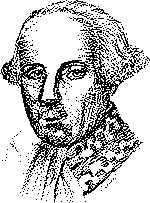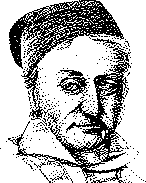Famous Mathematicians
(Thank you to the Department of Education, New South Wales, Australia
for use of the sketches of the mathematicians shown below.)

|
Did you know that one of the world's most brilliant mathematical minds was a New Zealander, Alexander Aitken? He was able to multiply two 9-digit numbers together in his head and recite the answer in 30 seconds and to render awkward fractions into decimals to 26 places in under five seconds. His extraordinary abilities were studied by psychologists in Britain during the 1920s. To find out more about him click here. |
Pythagoras was a philosopher, astronomer, geometrician and mathematician. He was founder of the Pythagorean school or brotherhood. Its members took oath to keep the teachings secret and to hold the same beliefs. Members of the brotherhood were concerned with relationships be between whole numbers and felt they were mystical. Pythagoras discovered the amicable or friendly numbers. Numbers are amicable if each is the sum of the proper divisors of the other e.g. 284 and 220. There are more than 900 pairs of amicable numbers. Probably the best known mathematical formula is credited to Pythagoras. His Pythagoras theorem relates the sum of the squares of two shorter sides of a right angled triangle to the square of the hypotenuse. In astronomy he taught that the Earth was a sphere located at the centre of a spherical universe . |
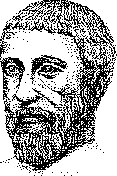 |
Euclid was a mathematician in Alexandria in Egypt. He is famous for his work called the "Elements". This became the most famous and influential set of text books in the world for many centuries and was an introductory text book covering all of the elementary mathematics known at that time. It covered the work on proportion by Eodoxus and the geometry of Pythagoras. The "Elements" consisted of 13 books covering such topics as quadratic equations and the construction of the five regular solids and of their circumscribed spheres. Euclid was the first Mathematical Principal at the Museum of Alexandria where he taught for many years. His work laid the foundation for the studies of such mathematicians as, Eratosthenes and Apollonius.
|
|
Archimedes is regarded as the greatest of the earlier mathematicians and one of the greatest of all time. He estimated the area of a circle by drawing a polygon outside the circle and a similar polygon inside the circle (inscribed and circumscribed) and saying that the area of the circle must lie between the areas of the two polygons. The more sides the polygon has the more accurate the answer. He tried this with polygons of up to 96 sides. This approach was the forerunner of integral calculus discovered many centuries later. He was thus able to find a more accurate value for pi. He discovered the formulae for the surface area and volume of a sphere and the areas of cylinders, parabolic segments and spirals. He also did work involving statics and hydrostatics and he determined that the ratio of the volume of a sphere to that of its enclosing cylinder is 2:3. The monument placed over his tomb in Syracuse where he was born and died was in the sculptured form of a sphere enclosed by a cylinder.
|
. |
A Greek mathematician, astronomer and geographer who was born in Egypt. His theory of the Universe held that the earth was the centre of the Solar system. This view was held until the time of Copernicus and
|
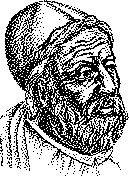 |
Hypatia lived and worked in Alexandria, on the mouth of the river Nile, at the time when it was the centre of Greek intellectual life. Ptolemy founded a university there, and to staff it he invited scholars from all over the world. Euclid, the famous Greek mathematician, was head of the mathematics department. Hypatia was the daughter of Theon, a noted mathematician and astronomer. She lectured on mechanics, mathematics, philosophy and astronomy and built instruments such as the astrolabe for measuring the positions of the stars. She also wrote a book called "On the Conics of Apollonius" about the conic sections, curves such as the parabola,the ellipse and the hyperbola, which had fascinated her Greek ancestors. She also is thought to have written a book about the work of Diophantus one of the earliest students of algebra. Hypatia was thought to have been murdered, the victim of a power struggle between two Alexandrian leaders, a Christian and a Roman. One legend says that the flesh was scraped from her bones with oyster shells !
|
 |
He was born in Uzbekistan in the southern part of the Soviet Union. His full name was Abu-Abdullah Mohammed ibn-Mus Al-Khowarizmi. He lived most of his life in Baghdad, now known as Iraq. That part of the world was on all of the major trade routes and was considered a centre of learning and many mathematical ideas were discussed and passed on there. Al-Khowarizmi recognised the usefulness of the Hindu-Arabic number system, the decimal system on which our present day numbers are based. He wrote a book on place-value and on topics such as astronomy and geography. He is best known for his work on solving equations and he developed the method of applying operations to both sides of an equation. His book on this systematic approach to algebra was the first of its kind and was used for centuries and used in many countries and became known as Al-jabr and eventually "Algebra".
|
|
Fibonacci was born in Pisa on the north coast of Africa. His father was a businessman and Leonardo received a Moorish education as well as a European one. He was widely travelled around the Mediterranean and met with many different systems of arithmetic and number. Europe was still using the Roman and Greek alphabet for numbers and the abacus still had to be used for calculations. Fibonacci helped to introduce the Hindu-Arabic number system. He showed by examples the superiority of these numbers 1,2,3,4,5,6,7,8,9,0 over the Roman equivalent. He is also accredited with being the first person to use a bar for fractions to separate the numerator and denominator. He was also interested in sequences and series and the famous Fibonacci series was demonstrated in a problem involving rabbits. This concerns a pair of rabbits which breed every 2 months....how many pairs of rabbits can be reproduced from that pair in a year, if each month, each pair, reaching the age of 2 months, reproduces another pair. This gives rise to the sequence :1,1,2,3,5,8,13,21... where each term is the sum of the two previous ones.
|
|
Copernicus was born in Poland at a time when the sea was becoming the new link for trade and travel. This meant that navigation techniques had to be developed and by the time he was 40, Copernicus had achieved the status of a distinguished astronomer. He developed his heliocentric system, against the current thinking, which states that the sun is the centre of the solar system, and that the planets revolve around it. Mathematics and logic were required to plot the paths of the planets around the sun and despite opposition marked the beginning of the cosmological revolution which inspired such great mathematicians as Galileo, Kepler,and Newton.
|
|
Cardano was born in Pavia in Italy. He was a man of great intellect and he was brilliant in several different fields including mathematics, astrology and medicine. In 1547 he became Professor of Medicine at Pavia University and at the University of Bologna in 1562. He was a gambler, and lost, and he was considered short-tempered,vindictive, conceited and pleasure-seeking. An interesting character ! He did a lot of work on algebra and published a book on the subject in 1545 called "Ars Magna" Another book he wrote was called "Liber de Ludo Aleae" or Book on Games of Chance and this book contained the first study of the principles of probability 100 years before Pascal and Fermat examined the problem. In this book he gives the advice,"The greatest advantage in gambling comes from not playing at all". Maybe he should have taken his own advice! He also published a horoscope of Christ's life − for which he was jailed by the authorities.
|
. |
John Napier was born in Edinburgh in Scotland. As a Laird he was well educated in France spending most of his early years studying agriculture on his farms. He was an inventor and he invented war machines such as a tank-like chariot, guns with a range of 4 miles and "burning mirrors" to stop a Spanish Armada. Mathematics was his main area of interest and he studied methods for extracting all real roots of positive numbers and began to consider imaginary roots. His major work, however was concerned with calculating methods. One such method was using numbered rods, known as Napier's Bones to perform multiplication and division. His main invention were logarithms. This ingenious method, which simplified long multiplication and division ,consisted of writing each number as a powers of 10, which could then be added or subtracted , and then re-writing them as ordinary numbers. Logarithms, shortened to logs, were used right up to the invention of the electronic calculator. Logarithms are also used to help solve exponential equations and in many other mathematical calculations.
|
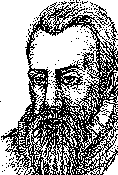 |
Galileo was born in Pisa on the day that Michelangelo died and he died aged 78 in the year that Newton was born. He entered the University of Pisa at age 17 to study medicine but turned to mathematics and soon began lecturing. In 1589 he became a Professor at the University and he then spent 18 happy years at Padua. He published his first paper at age 46 and this was what made him famous. He invented a telescope in 1609 through which he could see the mountains of the moon,the nature of the Milky Way, lots of previously unseen stars and four of Jupiters moons. Galileo also worked with ideas about infinity. He wrote that the infinity of points on a line, is greater than the infinity of points on a shorter line. He also pointed out that there are just as many squares 1,4,9,16 and so on as there are natural numbers 1,2,3,4... even though the squares are part of the natural numbers. His final years were unhappy and he was buried in an unmarked grave after a long running controversy with the church.
|
 |
Kepler was born at Weil in Germany. He studied at the University of Tubingen and then became a maths teacher at Graz. He studied astronomy, and developed his laws of elliptical orbits. Kepler bridged the gap between geometry and astrology. His conception of the Solar System ascribed elliptical orbits to the planets with the sun as a common focus. Kepler's Laws of Planetary Motion were :
|
|
Renee Descartes was born near Tours in France. He revolutionised mathematical concepts and ushered in modern mathematics. He was a philosopher and a modest man who declared toward the end of his brilliant life, that he had always felt like a boy playing by the seashore, while the great ocean of truth lay all undiscovered before him. On leaving school he joined the world of the Parisian wealthy and later the army when he fought in the Thiry Years War. His spare time was spent studying mathematics and he was also interested in a new invention of the time, the telescope. He went to Holland to escape the distractions of Paris and find time to meditate and search for truth. In 1637 he published a book outlining his views on philosophy and first mentioned his coordinate system for geometry, now known as the Cartesian system. He went to Sweden in 1649, and died soon after of pneumonia.
|
|
Fermat was born in Beaumont-de-Lomange in France. He has been called the greatest French mathematician of the 17th century. He received his education at home and excelled in the classics and wrote poetry. He became a lawyer and worked as a counsellor to the Parliament of Toulouse. He was a quiet man who spent much of his free time studying mathematics. Fermat's outstanding contribution was in the founding of the modern theory of numbers. He did a lot of work on the theory of probability and he was responsible for the Principle of Conjunctive probability which states that "if the probability of two events happening is H and K, then the probability that both events will happen is HK" This theorem is now studied at secondary school level. He was a brilliant, intuitive and inspiring mathematician and he communicated his findings not through journals and publications but by writing and corresponding with Europe's greatest mathematicians of the time.
|
. |
Pascal, who was born at Clermont- Ferrand in France, was educated by his family and by the time he was 12 he could work out most of the theorems of elementary geometry. At 14, he was taking part in weekly gatherings of mathematicians from which the French Academy was formed in 1666. When he was 16 he discovered some new and interesting theorems concerning the geometry of the conics. He invented a calculating machine when he was19, the ideas of which were still being used hundreds of years later. He studied the cycloid in 1658 as a distraction from a severe case of toothache! This work played an important part in the early development of the methods of calculus. Along with Fermat he developed the mathematical theory of probability and Pascal's Triangle is used in the theory of combinations and series. He also investigated the mathematics of magic squares.
|
|
Isaac Newton was born in Lincolnshire, England. His achievements in mathematics matched his more famous scientific ones. He wrote a letter in 1676 to Mr H. Oldenburg, the secretary of the Royal Society describing his discovery of the binomial theorem extended to fractional and negative exponents and hence the binomial series.He wrote the "Methods of Fluxions" in 1671. In thiswork Newton studies rates of change and calculus. In his book "Arithmetica Universalis" he examine many important results in the theory of equations, such as imaginary roots for real polynomials. As a mathematician, Newton is rated one of the greatest of all time . His insight into problems and his ability to treat them mathematically have probably never been excelled.
|
|
Leibniz was born in Saxony and became the greatest pure mathematician in Germany in the 17th century. He had many talents and was a philosopher, lawyer, language expert and geologist. He entered the University of Leipzig when he was only 15 and was refused his doctorate of law because he was too young, so he turned to mathematics. In 1667 he got a job with the Elector-Archbishop of Mainzand and was able to travel extensively and meet many of the great mathematicians and scientists of the time. He was elected a Fellow of the Royal Society in 1673 and in 1700 he helped found the Berlin Academy. He worked at the same time as Isaac Newton on calculus and invented a calculating machine. Leibniz and Newton developed the concepts of differential and integral calculus building on the earlier work of Archimedes, Fermat and Pascal. Both had their own approach with Leibniz's notation now generally accepted. The argument as to who discovered the calculus raged until his death and only one mourner turned up at his funeral.
|
|
Johann Bernoulli was born in Basle, Switzerland in a family that contained nine eminent mathematicians. He first studied medicine but he grew tired of that and turned to mathematics with his brother Jacques. He became a Professor of Mathematics at the University of Groningen on the recommendation of another famous mathematician C. Huygens. He worked on a wide range of topics. He is remembered for his work on exponential calculus, on complex numbers and for his treatment of trigonometry as a branch of calculus. His work on the problem of the curve of quickest descent joining two points- the brachystochrone- and the problem of finding the curve of given perimeter which encloses the greatest area, led him to be one of the founders of the calculus of variations. The collected works of his lifetime were published six years before his death in four volumes.
|
. |
Euler (pronounced "Oiler") was born in Basle in Switzerland. His father was his first teacher and later he was taught at the University of Basle by Johann Bernoulli. He also studied theology, oriental languages and physiology. He had a distinguished academic career. In 1727 at the age of 20 he was invited by Catherine of Russia to take the chair of mathematics at the new St. Petersburg Academy and in 1733 he succeeded Daniel Bernoulli as the Professor of Mathematics. In 1741 he accepted the invitation of Frederick the Great to head the Prussian Academy at Berlin and he remained there for 25 years. He devised Euler's method for solving differential equations. His greatest love was geometry and one of his papers concerns the formula V − E + F = 2 which connects the number of vertices, edges and faces of cuboids and polyhedra. He also contributed the following notation : f(x) − functional notation ; e − natural logs; a,b,c for the sides of triangles; − the summation sign and i − used in imaginary numbers. He had an incredible memory and was an expert textbook writer presenting his problems with clarity and precision. He died, blind for 15 years, aged 76, in St Peterburg.
|
. |
Pierre Laplace was born in Normandy, France into a poor family. He showed so much academic promise that he was sent by his neighbours to school in Caen. He went on to become a mathematics teacher at the Beaumont Military School. He later moved to Paris and began to produce numerous papers on astronomy and mathematics. He published "Mecanique Celeste" about astronomy and "Exposition du Systeme du Monde" in which he used mathematical formulae to describe the Universe. In 1812 he wrote a book on probability "Theorie Analytique des Probabilities", on which most of the later developments on probability theory were based. He also worked on calculus and differential equations.He died in 1827, after a quiet life, exactly one hundred years after the death of Isaac Newton.
|
|
"Mathematics is the queen of sciences" and "the theory of numbers is the queen of mathematics" Gauss was born in Gottingen into a family of humble means and his ability was evident at an early age. He was asked by a teacher to add up the numbers from 1 to 100 and he did it in seconds by adding 100 and 1, 99 and 2, 98 etc. By age 11 he had worked out the general case of the binomial theorem (a + b). He began to read all of the works of famous mathematicians such as Euler & Newton. In 1796 he discovered the construction of the 17-sided polygon with a compass and ruler only. He pioneered many theories of higher algebra, trigonometry and geometry. He developed the general theory of functions and the nature of complex numbers.He was a man of simple means and led an uneventful life but was ranked along with Archimedes and Newton as one of the greatest of all mathematicians.
|
|
Mary Somerville was born in Scotland at a time when there was a new surge of interest in science and technology. She developed an early interest in algebra and geometry but she did not produce any significant work until later in her life. At age 47, she produced a book called the Mechanisms of the Heavens, which was a popularised account of Celestial Mechanics. This book remained a popular text for higher mathematics and astronomy for years to come. Along with Caroline Herschel, she became one of the first women members of the Royal Astronomical Society. She fought against the restrictions placed on women in Britain and the United States but was herself bound by these, often working in secret. She wrote best selling books which were essentially a popularisation and compilation of the contemporarystate of scientific knowledge. She died with mental faculties unimpaired aged 92 in Naples realising one of her great desires − to enjoy the full power of her mind as long as she lived.
|
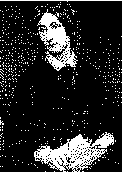 |
Sir Arthur Cayley was the first to formally develop matrices although it is thought that the Chinese may have used them about 1000 B.C. He made a vast contribution to mathematics and his name is given to the operation tables in number systems. He was very interested in algebra,the structure of mathematics and the theory of invariants. When Cayley first studied matrices there seemed to be no practical use for them, however much recent mathematics has involved the use of them and engineers, statisticians, scientists, economists and production managers all use them. He was a lawyer by profession and he also taught at Cambridge University in England. He enjoyed many outside interests including tramping, painting and architecture.
|
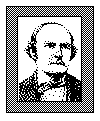 |
Sonya Kovalevskaya was born as the middle child of a noble Russian family at a time of change in Russia when Tsar Alexander II was promising the emancipation of the serfs and the reform of education as Russia entered the industrial age. She received a doctorate in 1874. |
